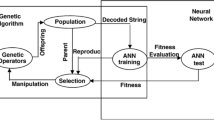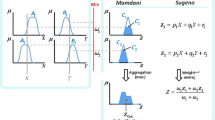Abstract
The strength behavior of a rock mass is often controlled by different discontinuities therein, along which the structural failures may threaten rock structures. Thus, the shear strength criteria for rock joints have always been a fundamental topic in rock mechanics. Knowing the different aspects of the rock joint shear strength based on the previously presented criteria, it is time to try different approaches other than the regression analysis in order to model the nonlinear behavior of rock joints. This research focuses on the estimation of the shear strength of rock joints using the computational intelligence. A total of 84 direct shear tests were first performed on replicas of natural rock fractures with various mechanical and morphological characteristics under several normal stress levels. Then, an adaptive neuro-fuzzy inference system (ANFIS) combined with a teaching–learning-based optimization (TLBO) algorithm was used to establish a new shear strength criterion. The results demonstrated that the ANFIS–TLBO criterion provided an accurate estimation of rock joint shear strength. A comparison between the ANFIS–TLBO criterion and the Barton’s empirical equation revealed a better performance of the suggested model in mapping the experimental data. The ANFIS–TLBO model’s residual indicated a random pattern, and its histogram exhibited a symmetric bell-shaped distribution around zero, supporting the appropriateness of the model.














Similar content being viewed by others
References
Babanouri N, Nasab SK (2015) Modeling spatial structure of rock fracture surfaces before and after shear test: a method for estimating morphology of damaged zones. Rock Mech Rock Eng 48:1051–1065
Babanouri N, Nasab SK (2017) Proposing triangulation-based measures for rock fracture roughness. Rock Mech Rock Eng 50:1055–1061
Babanouri N, Nasab SK, Baghbanan A, Mohamadi HR (2011) Over-consolidation effect on shear behavior of rock joints. Int J Rock Mech Min Sci 48:1283–1291
Babuška R (2012) Fuzzy modeling for control, vol 12. Springer, Berlin
Bandis S, Lumsden A, Barton N (1981) Experimental studies of scale effects on the shear behaviour of rock joints. Int J Rock Mech Min Sci Geomech Abstr 1:1–21
Barton N (1973) Review of a new shear-strength criterion for rock joints. Eng Geol 7:287–332
Barton N, Choubey V (1977) The shear strength of rock joints in theory and practice. Rock Mech 10:1–54
Belem T, Homand-Etienne F, Souley M (2000) Quantitative parameters for rock joint surface roughness. Rock Mech Rock Eng 33:217–242
Bezdek JC (1973) Fuzzy mathematics in pattern classification. Cornell University, Ithaca
Chiu SL (1994) Fuzzy model identification based on cluster estimation. J Intell Fuzzy Syst 2:267–278
Chiu S (1997) Extracting fuzzy rules from data for function approximation and pattern classification. In: Dubois D, Prade H, Yager R (eds) Fuzzy information engineering: a guided tour of applications, chap 9. Wiley, New York, pp 149–162
Crawford A, Curran J (1981) The influence of shear velocity on the frictional resistance of rock discontinuities. Int J Rock Mech Min Sci Geomech Abstr 6:505–515
Fahmi A, Abdullah S, Amin A, Ali A (2017a) Precursor selection for sol–gel synthesis of titanium carbide nanopowders by a new cubic fuzzy multi-attribute group decision-making model. J Intell Syst. https://doi.org/10.1515/jisys-2017-0083
Fahmi A, Abdullah S, Amin F, Siddiqui N, Ali A (2017b) Aggregation operators on triangular cubic fuzzy numbers and its application to multi-criteria decision making problems. J Intell Fuzzy Syst 33:3323–3337
Fahmi A, Abdullah S, Amin F, Ahmed R, Ali A (2018a) Triangular cubic linguistic hesitant fuzzy aggregation operators and their application in group decision making. J Intell Fuzzy Syst 34:1–15
Fahmi A, Abdullah S, Amin F, Ali A (2018b) Weighted average rating (war) method for solving group decision making problem using triangular cubic fuzzy hybrid aggregation (tcfha). Punjab Univ J Math 50:23–34
Fahmi A, Amin F, Abdullah S, Ali A (2018c) Cubic fuzzy Einstein aggregation operators and its application to decision-making. Int J Syst Sci 49(11):2385–2397
Fahmi A, Abdullah S, Amin F, Ali A, Ahmad Khan W (2018d) Some geometric operators with triangular cubic linguistic hesitant fuzzy number and their application in group decision-making. J Intell Fuzzy Syst 35(2):2485–2499
Fahmi A, Abdullah S, Amin F, Khan MSA (2019) Trapezoidal cubic fuzzy number Einstein hybrid weighted averaging operators and its application to decision making. Soft Comput 23(14):5753–5783
Fardin N, Stephansson O, Jing L (2001) The scale dependence of rock joint surface roughness. Int J Rock Mech Min Sci 38:659–669
Fattahi H (2016a) Indirect estimation of deformation modulus of an in situ rock mass: an ANFIS model based on grid partitioning, fuzzy c-means clustering and subtractive clustering J Geosci 1–10
Fattahi H (2016b) Application of improved support vector regression model for prediction of deformation modulus of a rock mass. Eng Comput 32:567–580
Fattahi H (2017) Prediction of slope stability using adaptive neuro-fuzzy inference system based on clustering methods. J Min Environ 8:163–177
Fattahi H, Babanouri N (2017) Applying optimized support vector regression models for prediction of tunnel boring machine performance. Geotech Geol Eng 35:2205–2217
Fattahi H, Karimpouli S (2016) Prediction of porosity and water saturation using pre-stack seismic attributes: a comparison of Bayesian inversion and computational intelligence methods. Comput Geosci 20:1075–1094
Fattahi H, Moradi A (2017) Risk assessment and estimation of TBM penetration rate using RES-based model. Geotech Geol Eng 35:365–376
Fattahi H, Agah A, Soleimanpourmoghadam N (2018) Multi-output adaptive neuro-fuzzy inference system for prediction of dissolved metal levels in acid rock drainage: a case study. J AI Data Mining 6:121–132
Gentier SS, Hopkins DL (1997) Mapping fracture aperture as a function of normal stress using a combination of casting, image analysis and modeling techniques Int J Rock Mech Min Sci 34:132. e131-132. e114
Grasselli G, Egger P (2003) Constitutive law for the shear strength of rock joints based on three-dimensional surface parameters. Int J Rock Mech Min Sci 40:25–40
Haque A, Indrarata B (2000) Shear behaviour of rock joints. CRC Press, Boca Raton
Hossaini KA, Babanouri N, Nasab SK (2014) The influence of asperity deformability on the mechanical behavior of rock joints. Int J Rock Mech Min Sci 70:154–161
Jang J-S (1993) ANFIS: adaptive-network-based fuzzy inference system. IEEE T Syst Man Cyb 23:665–685
Karimpouli S, Fattahi H (2018) Estimation of P-and S-wave impedances using Bayesian inversion and adaptive neuro-fuzzy inference system from a carbonate reservoir in Iran. Neural Comput Appl 29:1059–1072
Kulatilake P, Shou G, Huang T, Morgan R (1995) New peak shear strength criteria for anisotropic rock joints. Int J Rock Mech Min Sci Geomech Abstr 7:673–697
Ladanyi B, Archambault G (1969) Simulation of shear behavior of a jointed rock mass. In: The 11th US symposium on rock mechanics (USRMS). American Rock Mechanics Association
Lanaro F, Jing L, Stephansson O (1998) 3-D-laser measurements and representation of roughness of rock fractures. In: Mechanics of jointed and faulted rock. Balkema Rotterdam, The Netherlands, pp 185–189
Li K-h, Cao P, K Zhang, Zhong Y-f (2015) Macro and meso characteristics evolution on shear behavior of rock joints. J Cent South Univ 22:3087–3096
Maksimović M (1992) New description of the shear strength for rock joints. Rock Mech Rock Eng 25:275–284
Patton FD (1966) Multiple modes of shear failure in rock. In: 1st ISRM congress. International Society for Rock Mechanics
Rao RV, Savsani VJ, Vakharia D (2011) Teaching–learning-based optimization: a novel method for constrained mechanical design optimization problems Comput Aided Des 43:303-315
Saeb S, Amadei B (1992) Modelling rock joints under shear and normal loading. Int J Rock Mech Min Sci Geomech Abstr 3:267–278
Sarfarazi V, Haeri H, Shemirani AB, Zhu Z (2017) Shear behavior of non-persistent joint under high normal load. Strength Mater 49:320–334
Schneider H (1976) The friction and deformation behaviour of rock joints. Rock Mech 8:169–184
Tang ZC, Wong LNY (2016) New criterion for evaluating the peak shear strength of rock joints under different contact states. Rock Mech Rock Eng 49:1191–1199
Tang Z-c, Liu Q-s, Huang J-h (2014) New criterion for rock joints based on three-dimensional roughness parameters. J Cent South Univ 21:4653–4659
Tse R, Cruden D (1979) Estimating joint roughness coefficients. Int J Rock Mech Min Sci Geomech Abstr 5:303–307
Wei M, Bai B, Sung AH, Liu Q, Wang J, Cather ME (2007) Predicting injection profiles using ANFIS Inform Sciences 177:4445–4461
Wei Y, Fu W, Nie D (2015) Nonlinearity of the Rock Joint Shear Strength. Strength Mater 47:205–212
Weiling C, Lee J (1995) Fuzzy logic for the applications to complex systems. In: Proceedings of the international joint conference of CFSA/IFIS/SOFT on fuzzy theory and applications. World Scientific, Singapore
Wu J-D, Hsu C-C, Wu G-Z (2009) Fault gear identification and classification using discrete wavelet transform and adaptive neuro-fuzzy inference Expert Syst Appl 36:6244–6255
Yager RR, Filev DP (1994) Generation of fuzzy rules by mountain clustering. J Intell Fuzzy Syst 2:209–219
Zhang X, Jiang Q, Chen N, Wei W, Feng X (2016) Laboratory investigation on shear behavior of rock joints and a new peak shear strength criterion. Rock Mech Rock Eng 49:3495–3512
Zhao J (1997) Joint surface matching and shear strength part B: JRC-JMC shear strength criterion. Int J Rock Mech Min Sci 34:179–185
Author information
Authors and Affiliations
Corresponding author
Ethics declarations
Conflict of interest
The authors declare that they have no conflict of interest.
Ethical approval
This article does not contain any studies with human participants or animals performed by any of the authors.
Informed consent
Informed consent was obtained from all individual participants included in the study.
Additional information
Communicated by V. Loia.
Publisher's Note
Springer Nature remains neutral with regard to jurisdictional claims in published maps and institutional affiliations.
Rights and permissions
About this article
Cite this article
Babanouri, N., Fattahi, H. An ANFIS–TLBO criterion for shear failure of rock joints. Soft Comput 24, 4759–4773 (2020). https://doi.org/10.1007/s00500-019-04230-w
Published:
Issue Date:
DOI: https://doi.org/10.1007/s00500-019-04230-w




